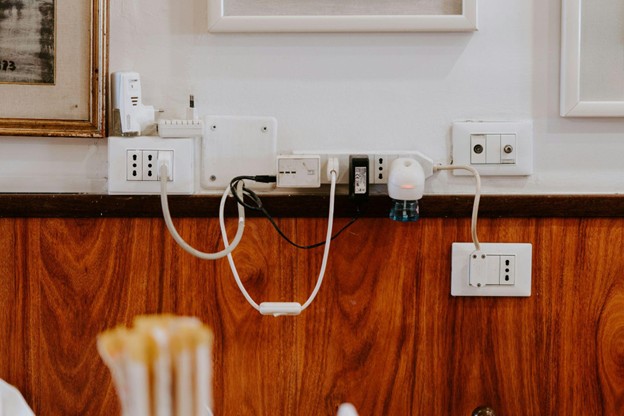Most of us don’t think twice about flipping a switch or plugging something in. Electricity feels like second nature to us at home, until something goes wrong. What’s hidden behind your walls or humming quietly in your outlets can be a serious threat when left unchecked.
Home electrical hazards aren’t always obvious, but they’re responsible for thousands of fires, injuries, and emergencies every year. A little flicker, a warm outlet, or a circuit that trips more than it should might not seem like much until it becomes a disaster.
Knowing what to watch for isn’t just about being cautious; you must protect your space, your things, and the people you love. These are the heavy hitters when it comes to danger.
1. Outdated or Damaged Wiring
Old or worn-out wiring doesn’t just struggle to keep up with modern appliances; it also gets brittle, overheats easily, and can break down unexpectedly.
If your home is over 30 years old and hasn’t been rewired, chances are high that the insulation is cracking or the wires themselves are no longer safe.
You might not see it, but you’ll feel it in tripped breakers, flickering lights, or warm wall plates. And when the wiring gets pushed beyond its limits, fire risk jumps through the roof. Rewiring may seem like a hassle, but compared to what’s at stake, it’s a no-brainer.
This is particularly crucial for the more humid tropical states. For example, if you are living in an old home in a historical area like Hyde Park, you need to be careful and call in an electrical contractor in Tampa to update the wiring.
2. Overloaded Circuits
Plugging too many things into one circuit isn’t just a power issue; it’s a fire waiting to happen. Homes today demand more electricity than ever before, but if your electrical panel or wiring hasn’t been updated to match, you’re running on borrowed time.
Overloaded circuits cause breakers to trip, wires to overheat, and devices to malfunction. Those extension cords and plug multipliers only make it worse.
If you constantly have to reset a breaker or unplug one thing to use another, that’s your system crying for help. A residential electrician can balance the load properly and give your setup room to breathe.
3. Faulty Outlets and Switches
If an outlet sparks, feels loose, or stays warm long after you unplug something, it’s not just annoying; it can be really dangerous.
Faulty outlets can signal loose wires behind the faceplate, damaged insulation, or even internal arcing. Switches that buzz or make popping sounds when flipped are equally concerning. These kinds of small issues often get ignored until they escalate into melted wires or wall fires.
Replacing outlets or switches isn’t a major job, but waiting too long can turn it into one. Any irregular behavior should be a prompt to call in a professional and replace the unit before it causes real harm.
4. Extension Cord Misuse
Extension cords are supposed to be temporary solutions, but plenty of households treat them like permanent fixtures.
Running cords under rugs, daisy-chaining them together, or using indoor cords outside all increase the chance of overheating or fraying. They can easily become pinched, cracked, or overloaded, turning into hot wires just inches from your furniture.
The worst part is that you won’t see the danger until it’s too late. If you find yourself relying on extension cords daily, it’s time to install more outlets or upgrade your electrical setup to match your lifestyle. Convenience should never come at the cost of safety.
5. Lack of GFCI Protection
GFCIs, or Ground Fault Circuit Interrupters, are required in areas with water exposure, like kitchens, bathrooms, garages, and outdoor spaces. They shut off power the moment they detect a fault, preventing electrocution and shock. But not all homes have them where they should.
If your bathroom outlets don’t have reset buttons, or your kitchen outlets spark when appliances are plugged in, you’re missing a key safety feature.
GFCIs are especially crucial if you’ve got kids, pets, or elderly family members in the house. Getting them installed is simple and affordable, and skipping them just isn’t worth the risk.
6. Exposed Wiring
Any wire that’s visibly exposed, whether it’s hanging from a ceiling, tucked behind an appliance, or running along baseboards, needs attention, fast. It doesn’t take much for exposed wiring to short out, especially if it gets wet or chewed by pets.
And the damage it can cause spreads quickly, turning into scorched outlets, smoke, or full-on electrical fires. Even low-voltage wires aren’t harmless if they’re part of a faulty setup.
If you see any wire that’s not properly enclosed or protected, don’t wait. Tape won’t fix it, and covering it up doesn’t make it go away. It needs to be handled properly.
7. Incorrect Wattage in Light Fixtures
Using a bulb with a higher wattage than a fixture is rated for might seem harmless, but it can actually melt the socket and start a fire. That’s called overlamping, and it happens more than people realize.
Even energy-efficient LED bulbs can be dangerous if the fixture or housing isn’t designed for the heat or circuitry involved. Always check the label inside the fixture, and never assume you can plug in a higher wattage because it “fits.” If the labeling’s faded or unclear, swap the fixture out or talk to an electrician who can install something updated and safer.
8. Improper DIY Electrical Work
YouTube tutorials have their place, but when it comes to electrical work, one wrong move can burn your house down. Whether it’s a sketchy ceiling fan install, a poorly grounded outlet, or mismatched wires, DIY jobs are some of the most common hazards electricians find.
What looks fine on the outside can be hiding serious problems behind the walls, like reversed polarity, overloaded boxes, or exposed copper.
Even something as simple as replacing a light switch can go sideways fast. If you’re not trained to handle electricity, leave it to someone who is. Your life’s not worth saving a few bucks.
9. Ungrounded Electrical Systems
Older homes built before the 1960s may still have two-prong outlets and no grounding in their wiring. That means when there’s a surge or fault, the electricity has nowhere to go but straight into you or your devices.
Grounding provides a safe path for stray voltage, reducing the chance of shock, damage, or fire. Without it, even your surge protectors won’t work correctly. You can’t just swap out the outlets for three-prong ones either; they need to be properly grounded.
An electrician can test your system and install updated wiring and outlets that give you real protection.
10. Neglected Electrical Panels
Your home’s panel is like the traffic cop for electricity. If it’s outdated, overcrowded, or showing signs of rust or corrosion, it can’t do its job.
Panels that aren’t labeled properly or have breakers that don’t respond as they should are a hazard in themselves. Sometimes panels aren’t even grounded or bonded correctly, which means they can’t shut down power when needed.
If your lights dim when an appliance turns on, or your breakers trip randomly, that’s your panel warning you something’s off. A licensed electrician can diagnose the issue and either upgrade or reconfigure it to restore proper flow and safety.
Final Thoughts
Electrical hazards aren’t always dramatic. They don’t announce themselves with smoke and sparks. Most of the time, they simmer quietly, hiding behind drywall or buried in habit, until one day, they don’t. Knowing what to look for is the first step, but knowing when to call in help is just as important.
Home safety isn’t about being paranoid, it’s about being smart with the systems we rely on every single day. If something feels off, don’t wait until it proves you right. Protect your home and everyone in it by staying alert, informed, and willing to call in the pros when it counts.
image source: https://unsplash.com/photos/white-power-strip-on-brown-wooden-floor-qjX0QBtDXto





Be First to Comment